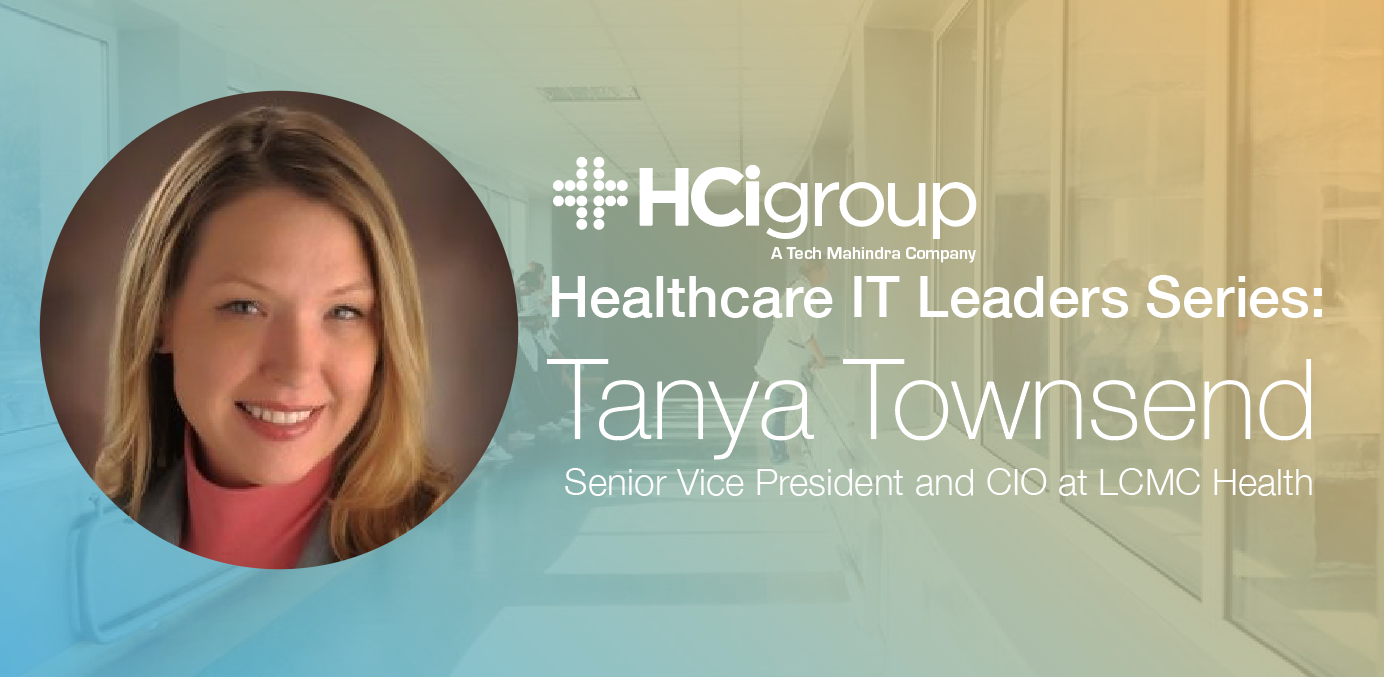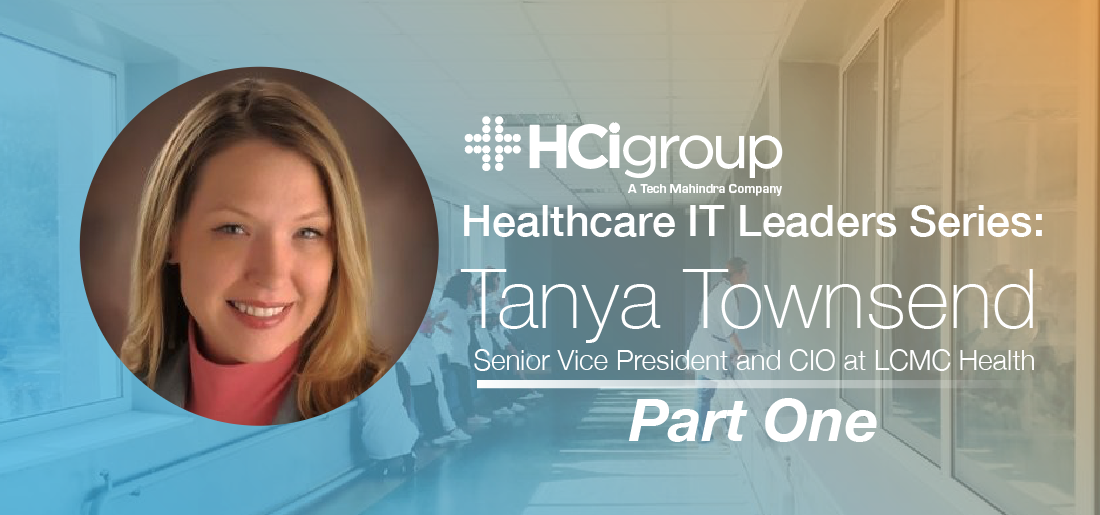Healthcare IT Leaders Series: Tanya Townsend (Part One)


Tanya Townsend, Senior Vice President & CIO at LCMC Health, joins The HCI Group for an exclusive interview as part of our Healthcare IT Leaders Series. In part one of this two part interview, Tanya gives her perspective on current trends in healthcare technology, aligning IT strategies with the rest of the organization and her journey to senior leadership.
Question: What are a few significant trends that you see impacting the healthcare industry today?
The movement towards patient and consumer friendly driven care; we need to make the healthcare experience more convenient and easier to access. It should be more transparent in what to expect when entering the healthcare arena. Also, providing more capabilities for patients to communicate with their healthcare providers anytime, anywhere. I think we are going to continue to see more and more movement to value versus volume. So, how do we ensure that we are providing quality care? I think our reimbursement trends will continue to move in that direction.
From a technology standpoint, I think we are going to continue to see more and more remote capabilities for patients to enter data into their medical records, whether that is Fitbits, iWatch or remote glucose readers, etc., I think that will remain a trend which supports more telemedicine capabilities. We are going to continue to have a challenge in how we manage the patient’s compliance with their healthcare. So, how do we partner together and engage our patients to improve their health and overall population?
Question: With those trends and where you see healthcare moving from an IT perspective, what are some of the big challenges that you see other healthcare organizations or yours facing?
In any organization, there is a bit of variance for where each entity lies on the IT maturity model. Some organizations have very robust IT structures that have been under development for many years, while others are still trying to catch up. "The biggest thing, from an IT perspective, is to truly understand where the organization is in that maturity. Sometimes it means blocking and tackling and putting in the foundations, while others have been early adopters of innovation and continue to push new technologies. Based on where that organization is from an IT perspective, it is really balancing between those two factors."
The other piece for an organization that is trying new things and is implementing new technologies is that you can't underestimate the disruption that the new things can have. They must make sure that they have operational partnerships in place to prepare for those changes. I also think that we are going to continue to have a challenge with resource management. There are so many mergers, acquisitions and innovative changes going on, all demanding IT talent. The demand for talent and the sheer complexity of the technology to interconnect these organizations and replace systems makes it really hard work, and I think the resource pool will continue to be stretched.
Question: How do you properly align your IT strategies with the overall business strategy of the organization?
Here at LCMC, we are a younger organization coming together and we recently built a new strategic plan so there was something that we could build upon. Recently, we had a retreat with our IT leadership, some of our key vendor partners, our physician informaticists, and even some operational stakeholders. We got in the room and really assessed how technology can support the strategic plan. We came away with a whole portfolio structure, which is now under development. We now have the framework and are aligning all the tactics, projects and strategies within the portfolio for a new three-year IT strategic plan.
Question: Referring to your personal and career background, what has been the most rewarding project that you have been a part of and worked on throughout your career?
I know it sounds cliché, but I’ve had many amazing experiences, so it is hard to pick just one. I’ve had the opportunity to build brand new hospitals from the ground up, I built one of the nation’s first all digital hospitals over a decade ago and I have led shared services models through mergers and acquisitions where we are now consolidating IT organizations. I have certainly had my fair share of electronic medical record implementations, and I’ve had the pre-Meaningful Use challenges of trying to sell an organization (or the medical staff) on CPOE evidence-based medicine.
I have also had the opportunity early in my career to roll up my sleeves, design and build systems as a systems analyst, and now work as a leader of such staff. I think the most rewarding attribute of these projects is the ability to influence change and create a new culture, particularly one that actively embraces technology in the healthcare industry. I started this plan over 20 years ago and got a degree in medical informatics at a time when nobody knew what that meant, and that was pre-Y2K. Having gone through that era to where we are today, it has really been a blessing and overall amazing experience, and I look forward to the next 20 years.
Question: What technologies are you using right now that you are most excited about, and why?
We are still in the midst of our Epic implementation, which does lead to so many exciting opportunities. So, today with what was five independent hospitals and organizations that were all running different platforms, we are now moving to Epic. This is our biggest strategy right now, to consolidate, gain efficiencies, integrate our care across the continuum and reduce all those complexities, which will to lead to a foundation for so many new opportunities.
In addition to Epic, we call our Epic implementation “Empire,” because we do like to stress it is not just Epic. While Epic does have a very robust platform, there are a lot of additional systems like voice recognition, single sign-on, archiving, tele-health, population health portals, and more.
Last but not least, as we continue to digitize all this information and have more and more access to information in different ways, we must make sure that we are protecting and securing our organization and our patients’ information. We are doing quite a bit around information security, with the people, the process, and new tools that help protect us from new threats and data loss, things that could happen if we are not careful.
Tanya Townsend Biography
Tanya Townsend is an established Healthcare Executive, most recently serving as the Senior Vice President and Chief Information Officer at LCMC Health, a 5 hospital system in New Orleans, LA. Tanya has been working in increasingly progressive roles in the healthcare industry for over 20 years. She has held positions of systems analyst, project manager, director, and CIO at 3 of the largest integrated healthcare delivery systems in the State of Wisconsin. Tanya received a Master of Science degree in Medical Informatics with undergraduate work in Healthcare Administration. In addition, she is a long-standing member of CHIME (the College of Healthcare Information Management Executives), is a Certified Healthcare CIO and has served on advisory boards for Epic Systems, VMWare, NetApp, and GE Health.


